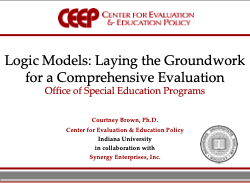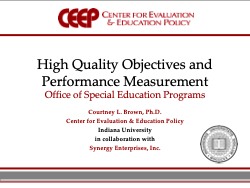OSEP's Technical Assistance and Dissemination Network
Download the full printable version of the Logic Model and Conceptual Framework with definitions.
Background
For the past 40 years, the Federal government has funded and managed special education technical assistance and dissemination (TA&D) projects as a way to build State and local capacity to serve children with disabilities and their families. The 1997 reauthorization of the Individuals with Disabilities Education Act consolidated the discretionary programs into six broad program areas, one of which was Technical Assistance and Dissemination. With most TA&D projects funded under one budget line, OSEP has worked to develop a comprehensive TA&D Network. This TA&D Network is currently comprised of approximately 40 TA&D projects that work at national and regional levels with State and local educational agencies, State and local Part C lead agencies, and families of children with disabilities to ensure that Parts B and C of IDEA are fully implemented.
Vision Statement
OSEP envisions TA&D projects within the TA&D Network working together to get information, knowledge, and support to those who need it including practitioners, parents, and policy makers. OSEP expects TA&D projects to leverage resources to expand their overall impact and capacity and to produce products and services that are consistently high-quality, relevant, useful, cost-efficient, culturally responsive, scientifically-based, and sustainable.
TA&D Network Logic Model
OSEP developed a logic model for the TA&D Network. The logic model depicts the goals, activities, and outputs for the TA&D Network and shows how diverse projects function together to achieve valued outcomes.
TA&D Project Conceptual Framework
OSEP has developed a project conceptual framework to articulate the underlying components that we envision for all TA&D projects. The components include knowledge development, technical assistance and dissemination, leadership and collaboration, and evaluation activities. The different components are connected and should influence one another through an iterative process. This framework has been developed as a general guide with the understanding that the degree to which these components are emphasized in individual projects will differ, as will the ways in which individual projects implement activities across the components.
Logic Model and Conceptual Framework Video Series
Logic Models: Laying the Groundwork for a Comprehensive Evaluation (Part 1)
This video is the first in the series and talks about Logic Models and why they are important in a comprehensive evaluation, what they consist of, and how to build an effective Logic Model. Please click on the video below to view the presentation. The PowerPoint for this presentation is also available to download.
High Quality Objectives and Performance Measurement (Part 2)
This video is the second in the series and talks about creating Logic Models, Objectives, and Performance Measures. Please click on the video below to view the presentation. The PowerPoint for this presentation is also available to download.

